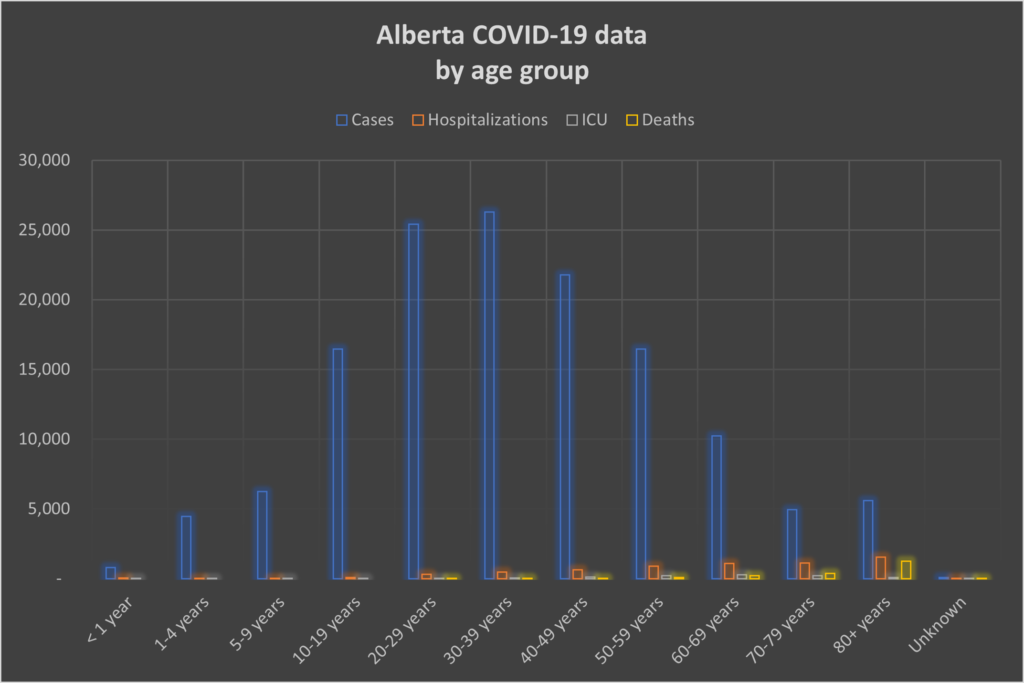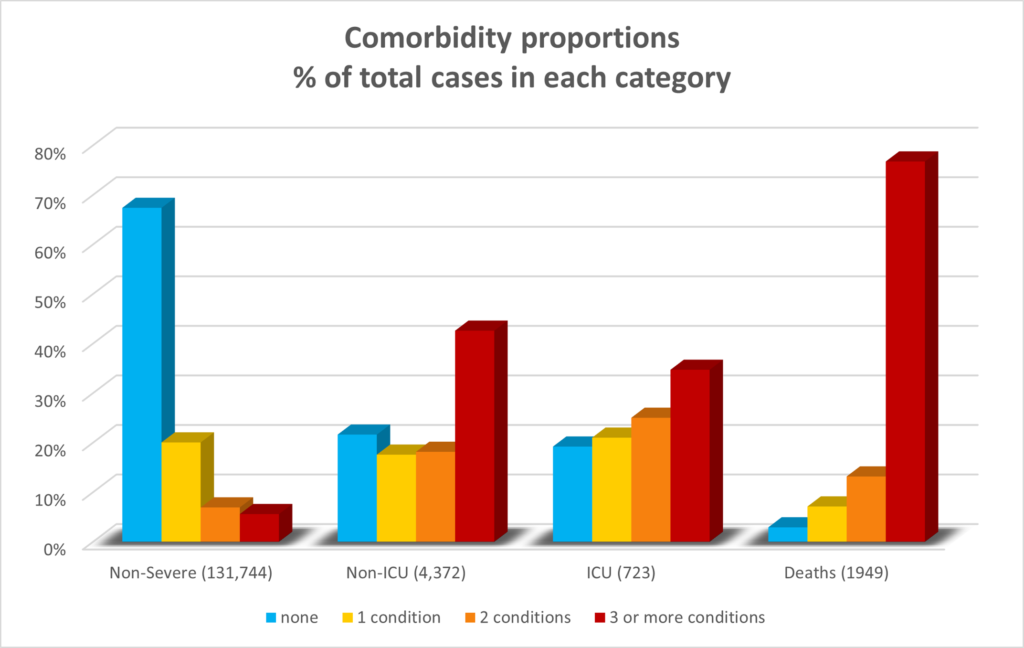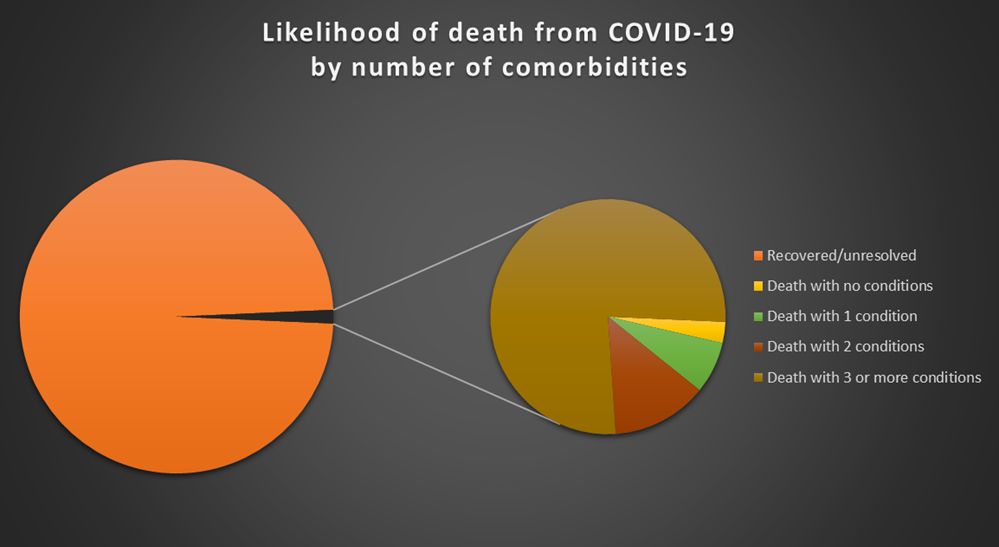There seems to be a common belief that young people are selfishly going about their business while the elderly drop like flies during the COVID-19 crisis; that the youth of today do not really care about the virus’s impact on our society.
As a 23-year-old Canadian university grad about to do veterinary school in the U.K., I can tell you that I care a lot. And I am frustrated by the steady barrage of sensational statistics in media reports that never seem to include context. I don’t know about you, but I would rather not hear the scariest part of the story on repeat. I want to know the REAL story.
So, I decided to do a dive into the COVID-19 numbers in my backyard of Alberta. This Canadian province of roughly 4.43 million people has a mix of urban centres and rural communities, so it should reflect the larger picture to some degree. However, this is a study on a specific region. I encourage you to do your own data dive, and I am guessing that your province or state has similar datasets available.
Keep in mind that my goal in this undertaking is simply to inform myself and anyone else interested in the results of my analysis. I hope to provide context that seems to be missing in public dialogue.
Getting to the heart of the issue, we will look at COVID-19-related deaths. It seems that a lot of people are deeply worried about the risk of death from COVID. Is such a level of concern warranted among the general population? Let’s examine the numbers in Table 1, shown graphically in Chart 1.

Table 1: Total hospitalization, ICU admission and deaths (ever) among COVID-19 cases in Alberta by age group. Note: Each ICU admission is also included in the total number of hospitalizations; Case rate is per 100 cases, and population (Pop.) rate is per 100,000.[1]

Chart 1: Graph of data from Table 1
It is important to note that these figures are totals, and not all of these people were in the hospital or had COVID at the same time. If you seek real-time information, visit the Alberta government official website at https://www.alberta.ca/stats/covid-19-alberta-statistics.htm or the government’s COVID-19 data dashboard in your region. The hospitalization and ICU numbers refer to the people who are hospitalized, or have been hospitalized but recovered or passed away. Looking at the “Deaths” column, you will notice “Count”, “Case rate”, and “Pop(ulation) rate”. The count tells us how many people have died in certain age groups. As you can see, until you reach the 20-29 age range, there have been zero deaths in Alberta. Does this mean COVID is not dangerous to those under age 20? Not necessarily – there are many who ended up in hospital, including in the ICU. The data table gives us no indication of whether the younger people had comorbidities, which hinders us from interpreting further in this category. Comorbidity is defined as when a person has more than one disease or condition affecting their health at the same time.[2]
The average age of death attributed to COVID-19 in Alberta is 81, with an age range in deaths of 20-107.[3] If there has been no death under 20 years old and most people in that group recover from COVID with little or no symptoms, why have young children and teenagers been forced to isolate if sick, and to halt activities that include others. Could we have let children continue their sport activities in a safe manner? Could we have let them stay in school and see their friends? We will never know if such an approach would have made other matters worse, but these are important questions to consider in case the pandemic endures or another arrives.
It has been roughly one year since COVID madness hit North America, so let’s assume that the 1,949 deaths in Table 1 are the number of deaths that have occurred in one year. We can see that death counts show modest increases from age groups 20s through 50s, and increase sharply in the oldest age groups. For the age group of 60-69, there have been 197 deaths.
There are, of course, no “year before” numbers with which COVID-19 data can be compared directly. However, for a little context, we can look at deaths from all causes in Alberta in the previous year, which numbered 26,268 from all age groups in 2019.[4]
One of the most interesting datasets (shown in Table 2) is the “number and percent of COVID-19 cases” with different levels of comorbidities.[5] This table breaks down level of health, and how likely one is to have non-severe COVID, be put in the hospital with COVID, in the ICU with COVID, and to die with COVID. Essentially, the more comorbidities you have, the worse your health. The percentages you see in Table 2 are the percentages for each column. There are four data sets: non-severe COVID cases, non-ICU COVID cases, ICU COVID cases, and COVID deaths. For example, in the non-severe column, 67.4% means that 67.4% of people who had non-severe COVID had no comorbidities, while 20.1% of people who had non-severe COVID had one comorbidity. This proportional relationship is illustrated in Chart 2. Note that these numbers are from March 14, 2021.

Table 2: Number and percent of COVID-19 cases with no comorbidities, one comorbidity, two comorbidities, or three or more comorbidities by case severity (non-severe, hospitalized but non-ICU, ICU but not deceased, and deceased), all age groups and both sexes combined, Alberta. Comorbidities included are: diabetes, hypertension, COPD, cancer, dementia, stroke, liver cirrhosis, cardiovascular diseases (including IHD and congestive heart failure), chronic kidney disease, and immune-deficiency.[6]

Chart 2: Graph of data from Table 2
Using the data from Table 2, we can better understand the death toll. To look at the percentage of people who died, we will do a simple percent calculation, where: For instance, when looking at “No comorbidity” cases (the first row in Table 2), the percent of people who die is:
For instance, when looking at “No comorbidity” cases (the first row in Table 2), the percent of people who die is:
Now, these case figures only include reported positive test results, so the number of cases is likely significantly lower than the actual number of COVID-19 infections because many people, particularly in younger groups, would have had the virus pass through them without having been tested, either because they had no symptoms or chose not to be tested despite having symptoms. For the sake of these calculations, we will work with the number of reported cases, understanding that some of the reported cases are ongoing/unresolved. All that said, the reported case data suggests that if you are an Albertan with no disease or medical condition who contracts COVID-19, there is less than 0.063% chance that you will die from the illness, regardless of age.
Continuing the calculations, we see that if you have one comorbidity, there is a 0.5% chance you will die with COVID-19. With two comorbidities, there is a 2.5% chance you will die with COVID. With three or more comorbidities, there is a 13.6% chance you will die with COVID. As you can see, if you have one or fewer comorbidities, the likelihood that you will die from COVID is negligible. (We recognize that even one death in a category can be deeply meaningful to many people, but we are looking purely at the numbers for this study.) See Chart 3 for a visualization of the relative sizes of these proportions.

Chart 3: Likelihood of death from COVID-19 relative to number of comorbidities.
If we use the 0.063% figure (does not factor in unreported COVID infections) your odds of dying after contracting COVID-19 are 1 in 1,587. I don’t think it is a stretch to say that most people I observe in my daily activities are much more concerned about meeting their end from COVID-19 than from falling (odds of 1 in 106)[7]or dying in an automobile accident (1 in 107).[8]Factoring in that 1,252 out of 1,949 deaths (64%) attributed to COVID-19 in Alberta are over age 80, and 94% of the fatalities are age 60 and older – if you are young, healthy, and worried about dying from COVID-19, you may want to read this story twice.
Given the distorted perception of risk among so many, it seems clear that we should be analysing data more carefully before taking – and, especially, pushing – a certain position on important matters. Yes, COVID-19 is a nasty virus. Yes, our society should have done a better job of protecting the vulnerable, particularly in long-term care homes. And, yes, virus variants and side effects are part of the evolving picture. However, it is important to put things in perspective and realize that the risk of death from COVID-19 is extremely low among healthy people.
Having looked closely at the numbers, I hope you will join me in breathing a safely distanced sigh of relief as we continue to do our best to avoid catching viruses, getting in car crashes, and falling off cliffs.
With files from Laurie Weston
[1] https://www.alberta.ca/stats/covid-19-alberta-statistics.htm
[2] https://www.cdc.gov/arthritis/data_statistics/comorbidities.htm
[3] https://www.alberta.ca/stats/covid-19-alberta-statistics.htm
[4] https://open.alberta.ca/opendata/alberta-annual-deaths-totals
[5] https://www.alberta.ca/stats/covid-19-alberta-statistics.htm
[6] https://www.alberta.ca/stats/covid-19-alberta-statistics.htm
[7] https://injuryfacts.nsc.org/all-injuries/preventable-death-overview/odds-of-dying/
[8] https://injuryfacts.nsc.org/all-injuries/preventable-death-overview/odds-of-dying/
(Skye Thompson – BIG Media Ltd., 2021)



Great article summarizing the facts and most importantly, putting them in perspective. MSM’s constant reporting of numbers without comparing them to other statistics (such as car crashes or even past pandemics) makes them just numbers. Governments know these statistics now and they must change their focus to protect the vulnerable and open up the economy immediately. However, until they have a holistic analysis integrating all facets of society, they will continue to succumb to global peer pressure rather than think for themselves.
Interesting and cogent summary of the data and analysis, Ms. Thompson.
The data does prove what I have long observed from the government dashboards and various reports, and while the mainstream media keeps trumpeting an escalating total death count, overall your work supports the co-morbidity and age related issues in the numbers.
Unfortunately, most media is very quick to publish the sensational numbers, not the actual rates and point out the overall low rates for younger/healthier part of the general population. While many have lost loved ones to Covid-19, the fact is everyone has an expiration date, and while it is tragic for the individuals and family members, it is also part of the human condition, and the current measures that treat everyone with the same lockdown measures are inappropriate. It will be interesting to see how the more infectious variants impact the numbers in the next 3-6 months.
Thank you for your work.
Thanks so much for the response. I agree the media has a tendency to sensationalize things lately so that’s why I wanted to do my own analysis of the numbers. I find media has a tendency to simply trumpet deaths, rather than other facts about COVID. I think every death from COVID is a tragedy, but on the other hand there needs to be reasonable approaches to disease management rather than blanket restrictions. I guess we will see how the variants affect things fairly soon, and (at least my hope) is that regardless things will start to get back to normal soon!